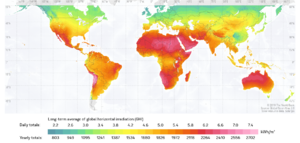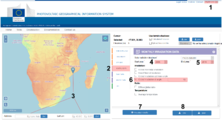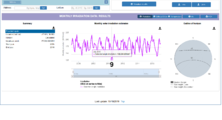Simplified weather and solar resource evaluation

Temperature and insolation largely determine the energy production of PV source. Temperature affects the performance of every component of an off-grid PV system, in almost all cases negatively. When designing an off-grid PV system the conditions under which a system will be operating will be factored into the design to make sure that the system can still deliver power when necessary even under the worst-case weather and solar resource conditions.
Information about the weather and solar resource for a location is most accurate when it is obtained from a nearby weather station that has many years of recorded data that can be analyzed at the level of days. Weather and solar resource can vary quite significantly from year to year and in the case of off-grid PV system design the months with the worst weather are the most important. Weather and solar resource data readily available on the internet, although there are print copies of this information for some locations. There is rarely local weather and solar resource data for remote locations where off-grid PV systems tend to be installed, which means that information must be used from the nearest site – which can be quite far away – or be obtained from an organization that provides estimates based upon computer models. There is no single definitive source for information that covers the entire globe and is available in many languages, although there are some resources that are close. These will be explored below.
There are additional resources available see - Resources and the pages dedicated to specific countries.
Contents
Temperature
There are several important temperature values that need to be determined to be able to properly design a PV system. If the location does not fit within the temperature ranges, then the detailed system design process should be followed. If uncertain about maximum and minimum temperatures in the location, consult local sources. PVGIS can be used for temperature data as well if necessary.
Maximum ambient temperature
The maximum ambient temperature for the location should not be above 50°C.
Minimum ambient temperature
The minimum ambient temperature for the location should not be below -15°C.
Maximum indoor temperature
The maximum indoor temperature should not be above 40°C.
Solar resource
For the purpose of PV system design, the solar resource for a given location is expressed as insolation in kWh/m². The insolation value for a location will vary each day throughout the year, therefore an off-grid PV system should be sized based upon the month with the lowest insolation or solar resource. This value will be used to size the PV source to ensure that system can generate enough energy to meet the demands for all loads and to recharge the battery bank during periods of poor weather. It is very important to use a conservative value for PV array sizing calculations.
There may be weeks in place like the Amazon rainforest, where it rains continuously for a week straight and the solar resource is very minimal. A system in a location like this may require a larger PV source, additional storage, or another form of power generation.
Obtaining solar resource data
There are many different sources of solar resource data available - see Resources and the pages dedicated to specific countries. The most accurate measure of the solar resource in a given area is Global Horizontal Irradiance (GHI) that has been adjusted for the tilt and azimuth of the PV source.
PVGIS
European Union - Photovoltaic Geographical Information System A free and very detailed production modeling, system design tool and source for weather data that works in most locations globally. Also available in Spanish, French, and Italian.
(1) Select language (2) Select type of data - "Monthly Data". (3) Select location the using a name, GPS coordinates, or double-clicking. (4) and (5) Select start and end year - the longer period of time the better. (6) Select "Global irradiation at angle:" and enter the intended tilt angle of the PV source. (7) Click "Visualize results." (8) For more detailed information, click ".csv" to export it as a spreadsheet.
| Minimum monthly solar resource | = Insolation value for the month with the lowest solar resource in kWh/m² |
|---|
Notes/referneces
- ↑ World Bank - Global Solar Atlas https://globalsolaratlas.info/map

